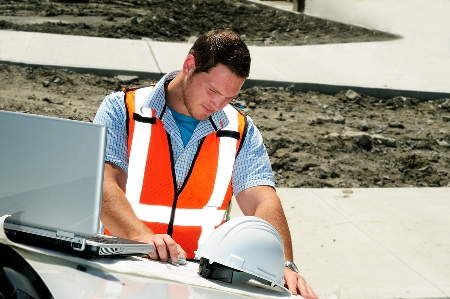Chris Williams reports exclusively.
Before last year's federal election Tony Abbott declared that if elected he wanted to be known as the "infrastructure Prime Minister", if he is to get his wish there is much work ahead.
According to the draft Productivity Commission report an abundance of flaws, mythologies and forgone opportunities currently plague infrastructure financing, funding and procurement.
"Australia is not a cheap place in which to build infrastructure, but the sources of the cost pressures that have created this situation are numerous and no single reform is likely to alter them. Action on a number of fronts is necessary," Peter Harris, the Presiding Commissioner and Commission Chairman, said.
Attracting private investment
The report outlines a proposed process for improving infrastructure investment across all levels of government, and as a consequence attracting increased private investment.
"Governments have it in their power to attract higher levels of private infrastructure investment, and to improve their own capacity to fund infrastructure, even in the presence of apparent borrowing constraints," Harris said.
"They can do this through the judicious use of pricing mechanisms and by collectively establishing stronger transparent processes for project identification, selection, design and implementation."
However the report also cautioned against imagining that private sector financing would provide a 'silver bullet' solution. While it said private sector involvement could deliver efficiency gains, ultimately taxpayers or users of infrastructure had to pay for it.
Pursuing the reforms, it said, could conservatively deliver $1 billion in savings annually.
Adrian Hart, Senior Manager - Infrastructure & Mining at research house BIS Shrapnel, is more cautious.
"We have two big negatives coming through," Hart told IndustrySearch.
"We are coming off the top of a major mining boom and governments instead of moving forward to provide infrastructure projects and otherwise stimulate the economy from the downturn are pulling back at the same time.
"What concerns me going forward about engineering construction is commencements. And commencements have been tracking well below work done for the last couple of years which is an obvious sign of a decline in construction work."
Behind the curve
Australia, Hart said, is still playing catch-up on non-mining infrastructure, dating back to the economic conservatism of the 1990s.
"The 1990s were a period of great under investment in infrastructure in Australia, we lived off investments that were made in previous decades, it was a decade of trying to rationalise, be more efficient, try to make the most use of what you've got, and it certainly cut budget deficits," Hart said.
"But by the end of the 1990s we started to run into capacity constraints and we had to invest in networks, energy, roads, transport, and utilities again.
"In the meantime we've had other booms come along, we've had a private funding boom, the private sector came into play in terms of building and funding infrastructure. Then we had a resources boom come in on top of that and it created a self-perpetuating virtuous cycle where governments were suddenly awash with funding.
"And they didn't know what to do with it – they were giving it away as tax cuts, rebates, benefits, every which way, then by 2004 we started to invest heavily in infrastructure again."
This investment however, Hart said, was focused on the needs of the time, namely servicing a once in a generation mining boom.
"So much of that infrastructure was driven by the mining sector. We are talking about building big LNG plants, multi-billion dollar ports purely to service the mining boom," Hart said.
"Since 2008 the actual increase in non-mining infrastructure has been negligible.
"I prefer us to be building ahead of the curve when it comes to infrastructure rather than behind it. We've been building just to cater for the next few years rather than for long term growth."
Looking forward
While Hart said infrastructure investment would ramp up again, the twin issues of funding and maintaining our existing infrastructure would also need to be addressed.
"One of the biggest issues facing infrastructure is how we fund it. We need to come up with new ways of financing it. I'd expect going forward that we might use asset sales to seed capital into new infrastructure projects because the private sector won't want to take on the risk as they have in the past," Hart said.
"Another issue I have is, are we really considering the maintenance of the stock we have? We are living off assets that were built in the fifties and sixties in NSW, a lot of our road infrastructure was built at that time and is coming to the end of its useful life. All of this infrastructure needs to be maintained."
Nevertheless, Hart said, investment would return, led by NSW and followed by the other states. He said BIS Shrapnel expected the strongest upswings in the transport sector – in roads, water and rail.
"Roads should pick up from here because of the range of very large projects that are being looked at right now. These are mammoth projects, we are talking tens of billions of dollars which will itself drive an upswing in road construction work," Hart said.
"Add in to that the usual amount of work we need to be doing on our rural and urban highways and local roads and you have a very strong prospect for roads moving forward.
"If Tony Abbott wants to be known as an infrastructure prime minister I'd advise him not just to look at roads but also at our rail networks as well because we'll need both right throughout the next decade."
Electricity and water
Electricity is a sector that has seen massive growth in investment in the last decade, but a lot of growth more recently has been driven by transmission and distribution works not generation, and according to Hart going forward our requirements for generation are weaker than they were.
"We don't need to be investing so much in our electricity networks as we have in the past," he said.
"As for water and sewerage, we had a big generational level of investment in water and some would argue that we invested too much in water in the past 5 years which is a bit harsh, but there is a lot of works we still need to support a growing population."
The release this month of the March Australian Performance of Construction Index (PCI) supports Hart's view that Australia has a long way to go to redress the post-mining boom infrastructure imbalance, with engineering construction still in decline.
Australian Industry Group Director – Public Policy, Peter Burn, said the rebalancing of the construction sector as mining-related activity slowed still had a considerable way to go, but that with commercial and residential construction showing recent improvement: "Attention can turn to the remaining missing link - greater investment in non-mining related engineering construction."
"The scene is set for a major focus on new infrastructure investment," Dr Burn said.
All eyes then on the self-proclaimed "infrastructure Prime Minister" for the next move.





-160x160-state_article-rel-cat.png)



-160x160-state_article-rel-cat.png)



-160x160-state_article-rel-cat.png)










